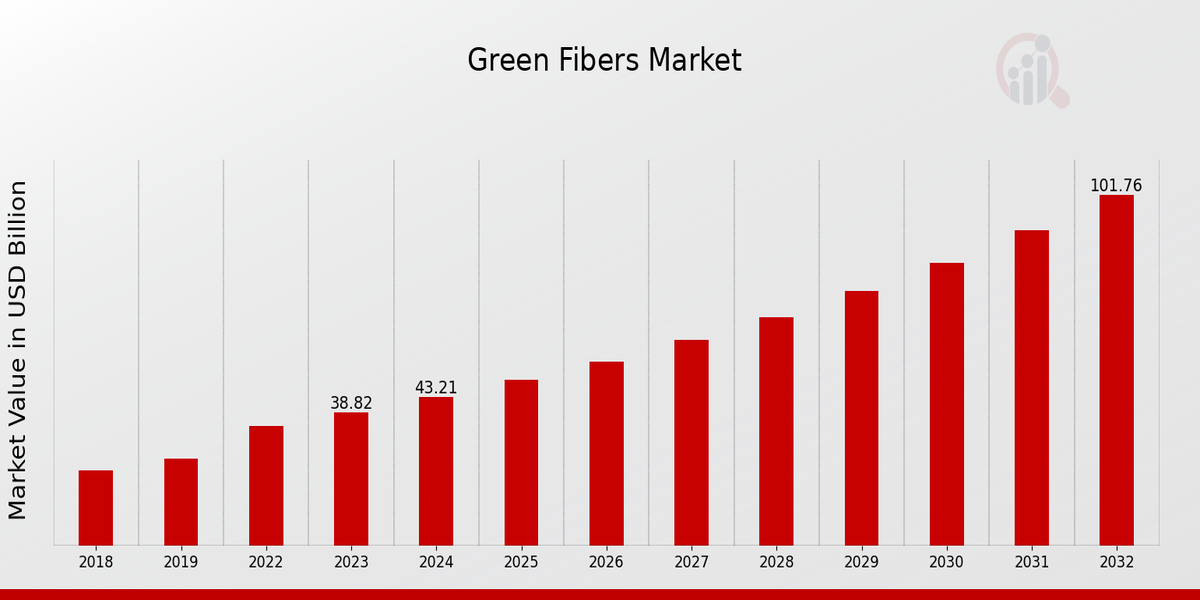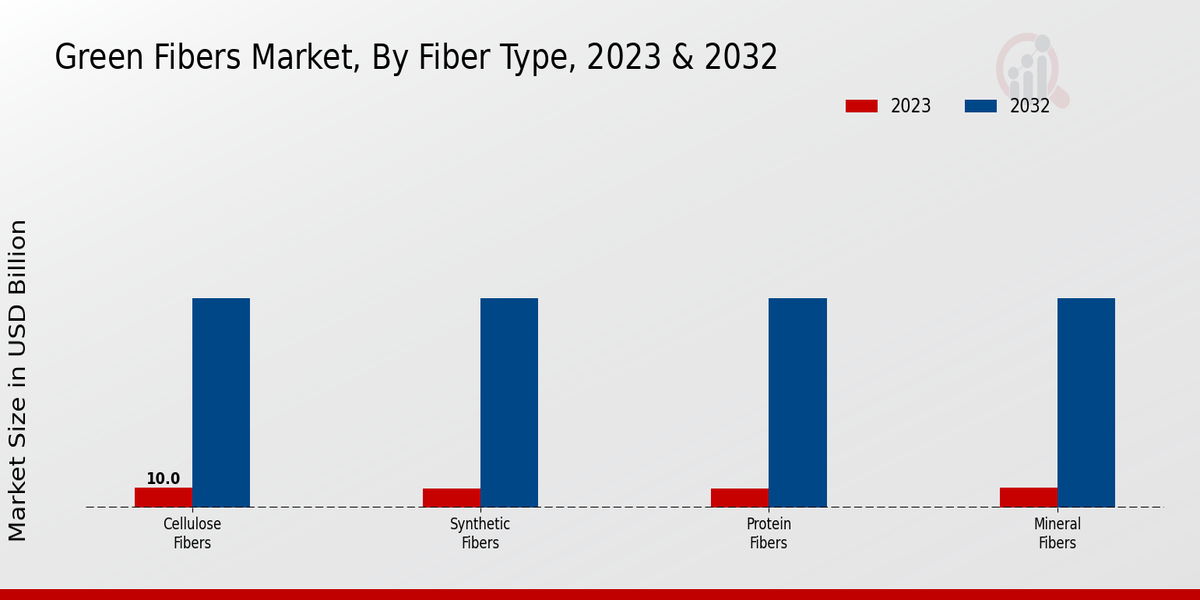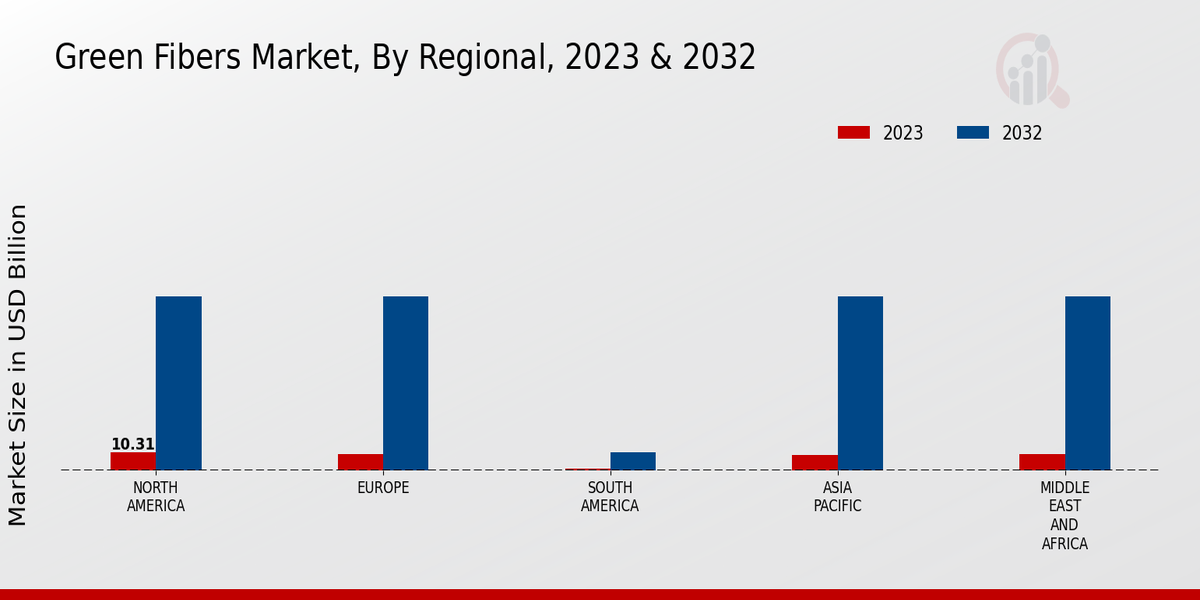Global Green Fibers Market Overview
The Green Fibers Market Size was estimated at 48.12 (USD Billion) in 2024. The Green Fibers Industry is expected to grow from 53.56 (USD Billion) in 2025 to 140.62 (USD Billion) by 2034. The Green Fibers Market CAGR (growth rate) is expected to be around 11.3% during the forecast period (2025 - 2034).
Key Green Fibers Market Trends Highlighted
In the Green Fibers market, the increasing demand for sustainable and eco-friendly solutions has emerged as a key market driver. Consumers are becoming increasingly aware of the environmental impact of synthetic fibers, leading to a surge in demand for natural and biodegradable alternatives. This trend is driven by growing concerns about microplastic pollution, waste reduction, and the promotion of a circular economy.
Opportunities for exploration within the Green Fibers market lie in the development of innovative and high-performance green fibers. These fibers offer advantages such as increased strength, durability, and moisture management, making them suitable for a wide range of applications. Additionally, the emergence of bio-based and plant-derived fibers presents opportunities for sustainable and cost-effective sourcing.
Recent trends in the Green Fibers market have highlighted the growing adoption of cellulose-based fibers, such as lyocell and modal. These fibers are derived from renewable resources and offer properties similar to cotton, making them ideal for use in textiles, nonwovens, and hygiene products. Furthermore, the development of recycled and upcycled fibers is gaining traction, driven by the need to reduce textile waste and promote circularity within the fashion and apparel industries.
 Source: Primary Research, Secondary Research, MRFR Database and Analyst Review
Source: Primary Research, Secondary Research, MRFR Database and Analyst Review
Green Fibers Market Drivers
Rising Environmental Awareness and Regulations
Consumers are becoming more and more aware of the environmental impact of their purchases every day, and they realize the importance of buying products that have less of a hit on the environment. On the other hand, governments impose laws and regulations on the industrial sectors to have a smaller environmental impact, which increases the rise of the Green Fibers Market Industry. For example, the European Union has laid a target for its member countries to decrease greenhouse gas emissions by 40% by 2030.At the same time, due to the new campaign, fashion has become popular as eco-friendly fashion. Consequently, as people strive to buy more sustainable and ethical clothing, their demand for green fibers is bound to grow. Thus, taking into consideration all of the above-stated facts, it is possible to conclude that the growing awareness and regulation initiate a fantastic growth opportunity for the Green Fibers Market Industry.
Technological Advancements
The development of new technologies is expected to be a key driver of the growth of the Green Fibers Market Industry. The development of bio-based fibers lowers the dependence on fossil fuels. The development of new spinning and weaving technologies reduces the costs of production and enhances the quality and performance of green fibers. The demand and use of green fibers are increasing, and their applications are expanding. This is being driven by a number of factors, including the attractiveness of green fibers to consumers, environmental concerns from both consumers and producers, an increasing number of manufacturers, technological advancements in the production of green fibers and their performance, and low costs of production.
Growing Demand from End-Use Industries
The growing demand from end-use industries is another major factor responsible for the growth of the Green Fibers Market Industry Ref. Green fibers are used in a broad range of end-use industries, such as automotive, construction, and textiles, among others. In the automotive industry, green fibers are used to manufacture lightweight and fuel-efficient vehicles. In the construction industry, green fibers are used to manufacture sustainable building materials.In the textile industry, green fibers are used to manufacture eco-friendly clothing. Thus, the rising demand from various end-use industries offers a beneficial growth opportunity to the Green Fibers Market Industry.
Green Fibers Market Segment Insights
Green Fibers Market Fiber Type Insights
The Green Fibers Market is segmented based on Fiber Type into Cellulose Fibers, Synthetic Fibers, Protein Fibers, and Mineral Fibers. The cellulose Fibers segment is estimated to hold the major market share in 2023 and is expected to continue its dominance throughout the forecast period. The major factor contributing to the growth of the segment is the increasing demand for sustainable and biodegradable materials. Cellulose fibers are derived from plant-based materials such as wood pulp and cotton, making them environment-friendly options. The synthetic Fibers segment is expected to witness a significant growth rate during the forecast period.The increasing demand for lightweight and durable materials in various industries, such as automotive aerospace, is driving the growth of the segment. Synthetic fibers are made from petrochemical-based materials and offer properties such as high strength, low weight, and resistance to chemicals. Protein Fibers segment is gaining traction owing to its unique properties and its applications in various industries. Protein fibers are derived from animal and plant sources, such as wool, silk, and soy protein, and offer properties such as biodegradability, moisture absorption, and flame resistance.The increasing demand for sustainable and functional materials is expected to drive the growth of the Protein Fibers segment. Mineral Fibers segment is expected to experience moderate growth rate during the forecast period. Mineral fibers are derived from inorganic materials, such as glass and rock wool, and offer properties such as high thermal insulation, fire resistance, and sound absorption. The increasing demand for energy-efficient buildings and strict fire safety regulations is expected to drive the growth of the segment.
 Source: Primary Research, Secondary Research, MRFR Database and Analyst Review
Source: Primary Research, Secondary Research, MRFR Database and Analyst Review
Green Fibers Market Production Method Insights
The Green Fibers Market Research report has provided a detailed overview of the market along with a qualitative and quantitative analysis of the market. The market has been segmented on the basis of Production Methods into Plant-Based Fibers, Animal-Based Fibers, Lab-Grown Fibers, and Recycled Fibers. The Plant-Based Fibers segment dominates the market with a share of more than 50% in 2023. The growth of this segment is attributed to the increasing demand for sustainable and eco-friendly materials. The Animal-Based Fibers segment holds the second-largest share in the market, followed by Lab-Grown Fibers and Recycled Fibers.The Lab-Grown Fibers segment is expected to grow at the highest CAGR during the period under consideration.
Green Fibers Market End-Use Application Insights
The end-use application segment plays a crucial role in shaping the dynamics of the Green Fibers Market. Among the various applications, textiles hold a significant share, driven by the increasing demand for sustainable and eco-friendly clothing, home textiles, and industrial fabrics. The automotive interiors segment is also expected to witness substantial growth as automakers prioritize lightweight and durable materials to enhance fuel efficiency and reduce emissions. Medical and hygiene products, such as surgical gowns, drapes, and wipes, are another important application area where green fibers offer improved infection control and reduced environmental impact.Furthermore, the packaging industry is increasingly adopting green fibers to create sustainable packaging solutions, contributing to the overall market growth.
Green Fibers Market Sustainability Insights
Sustainability is a key driver of growth in the Green Fibers Market. Consumers are increasingly demanding products that are environmentally friendly and sustainable. This has led to a growing demand for green fibers, such as biodegradable fibers, recyclable fibers, and low-carbon footprint fibers. The Green Fibers Market revenue from biodegradable fibers is projected to reach $10.2 billion by 2024, growing at a CAGR of 12.3%. Biodegradable fibers are derived from natural sources, such as plants and animals, and can be broken down by microorganisms.This makes them an environmentally friendly alternative to synthetic fibers. Recyclable fibers are another important segment of the Green Fibers Market. The Green Fibers Market revenue from recyclable fibers is projected to reach $12.5 billion by 2024, growing at a CAGR of 13.5%. Recyclable fibers can be reused multiple times, which reduces waste and conserves resources. Low-carbon footprint fibers are also gaining popularity in the Green Fibers Market. The Green Fibers Market revenue from low-carbon footprint fibers is projected to reach $8.7 billion by 2024, growing at a CAGR of 14.2%.Low-carbon footprint fibers are produced using processes that minimize greenhouse gas emissions.
Green Fibers Market Performance Characteristics Insights
The Performance Characteristics segment of the Green Fibers Market is expected to grow significantly in the coming years, driven by the increasing demand for sustainable and high-performance materials in various industries. The Strength sub-segment is anticipated to dominate the market due to the superior mechanical properties of green fibers, such as high tensile strength and modulus. The Durability sub-segment is expected to witness substantial growth owing to the excellent resistance of green fibers to degradation, abrasion, and chemicals.The moisture-wicking sub-segment is projected to gain traction as green fibers possess inherent moisture management capabilities, making them ideal for applications in sportswear and outdoor apparel. The Odor Resistance sub-segment is likely to experience significant demand due to the antimicrobial and odor-resistant properties of green fibers, leading to their use in hygiene products and medical textiles.
Green Fibers Market Regional Insights
The regional segmentation of the Green Fibers Market offers insights into the market's geographical distribution and performance across different regions. North America held the dominant position in the market in 2023, accounting for a significant share of the Green Fibers Market revenue. The region's robust textile and apparel industry, coupled with growing consumer awareness about sustainability, has contributed to its dominance. Europe is another key market for green fibers, driven by stringent environmental regulations and a strong focus on eco-friendly initiatives.The APAC region is projected to witness substantial growth in the coming years, owing to the increasing demand for green fibers from emerging economies such as China and India. South America and MEA are expected to contribute a smaller but growing share of the Green Fibers Market as these regions continue to invest in sustainable practices and explore the potential of green fibers.
 Source: Primary Research, Secondary Research, MRFR Database and Analyst Review
Source: Primary Research, Secondary Research, MRFR Database and Analyst Review
Green Fibers Market Key Players And Competitive Insights:
The Green Fibers Market is dominated by major companies that invest a lot in research and development to create innovative products that meet the needs of modern society. The leading players in the Green Fibers Market focus on developing new production technologies that will help reduce the negative impact on the environment. Moreover, they work closely with other players in the market reality in the sphere of the development of new, more sustainable solutions for the entire textile industry. The development of the Green Fibers Market is mainly driven by the growing demand of the population for more sustainable, environmentally friendly materials. Thus, more and more people have become aware of the pollution of air, water, and soil during the traditional production process of fibers and textiles, raising the demand for more sustainable clothing and home textiles. This trend is most likely to continue even in the future, thus favoring the development of the Green Fibers Market.It should be noted that one of the key players in the Green Fibers Market is Lenzing AG, one of the leading producers of cellulosic fibers, including Tencel, Modal, and Viscose. The company is highly concerned about environmental issues and aims to develop solutions that allow for reducing the environmental and social impact as much as possible. Lenzing AG invests in research and development to create innovative products as well. Eastman Chemical Company is another company that can be positioned among the major competitors of the Green Fibers Market since it is one of the leading producers of cellulose acetate fibers, used in garments, filtration, and packaging as well as industrial, nonwoven, and medical applications. Just like Lenzing AG, Eastman Chemical Company is highly concerned about environmental issues and is actively working to reduce the negative impact mentioned.
Key Companies in the Green Fibers Market Include:
-
Hyosung
-
Indorama Ventures
-
DuPont
-
Toray
-
Lenzing
-
Eastman
-
Basf
-
Unifi
-
Renolit
-
Asahi Kasei
-
Trevira
-
SABIC
-
Lenett
-
Teijin
Green Fibers Market Industry Developments
One of the major players in the green fiber market is Lenzing AG, one of the world’s leading producers of cellulosic fibers such as, Tencel, Modal and Viscose. The company is deeply concerned with the situation of the nature and, consequently, strives to formulate measures that would minimize the effects both on the environment and in the society as much as possible. Lenzing AG commits funds for research and development with the aim if coming up with new modernized products as well.
Another enterprise that can be placed among the primary contenders in the Green Fibers Market is Eastman Chemical Company; A United States based company that dominates the manufacture of cellulose acetate fibers which are used in garments, filtration, and packaging as well as industrial, nonwoven and medical uses. Exactly in the same manner as Lenzing AG, Eastman Chemical Company has directed its green fiber portfolio towards environmental protection requirements and makes efforts to reduce the negative impacts above mentioned.
Teijin Limited is a Japanese multinational corporation involved in offering diversified technologies, including sustainable and green fibers. Its product portfolio includes Eco CircleTM and BIOFRONTTM. The former is a closed loop recycling system for polyester fibers and products, while the latter is a biodegradable polyester fiber which is derived from plant-based materials.
Likewise, DuPont de Nemours Inc. offers pioneering innovations in material sciences, which includes sustainable and green fibers. Its main product is Sorona ®, a partial bio-based fiber which is manufactured from renewable plant-derived materials. The fiber is soft, easily stretchable and highly durable.
Grasim Industries Limited, an Aditya Birla Group company, offers the LivaecoTM product line. It comprises of a range of sustainable fibers which are sourced from forests with traceable production processes. The company has adopted advanced sustainability standards such as the FSC certification.
Green Fibers Market Segmentation Insights
Green Fibers Market Fiber Type Outlook
-
Cellulose Fibers
-
Synthetic Fibers
-
Protein Fibers
-
Mineral Fibers
Green Fibers Market Production Method Outlook
-
Plant-Based Fibers
-
Animal-Based Fibers
-
Lab-Grown Fibers
-
Recycled Fibers
Green Fibers Market End-Use Application Outlook
Green Fibers Market Sustainability Outlook
Green Fibers Market Performance Characteristics Outlook
-
Strength
-
Durability
-
Moisture Wicking
-
Odor Resistance
Green Fibers Market Regional Outlook
-
North America
-
Europe
-
South America
-
Asia Pacific
-
Middle East and Africa
| Report Attribute/Metric |
Details |
| Market Size 2024 |
48.12 (USD Billion) |
| Market Size 2025 |
53.56 (USD Billion) |
| Market Size 2034 |
140.62 (USD Billion) |
| Compound Annual Growth Rate (CAGR) |
11.3% (2025 - 2034) |
| Report Coverage |
Revenue Forecast, Competitive Landscape, Growth Factors, and Trends |
| Base Year |
2024 |
| Market Forecast Period |
2025 - 2034 |
| Historical Data |
2020 - 2024 |
| Market Forecast Units |
USD Billion |
| Key Companies Profiled |
Hyosung, Indorama Ventures, DuPont, Toray, Lenzing, Eastman, Basf, Unifi, Renolit, Asahi Kasei, Trevira, SABIC, Lenett, Teijin |
| Segments Covered |
Fiber Type, Production Method, End-Use Application, Sustainability, Performance Characteristics, Regional |
| Key Market Opportunities |
Biomaterials AdvancementsSustainability RegulationsTextile Industry GrowthEcoConscious ConsumersGovernment Incentives |
| Key Market Dynamics |
Increased demand for sustainable textilesGrowing consumer awareness of environmental impactTechnological advancements in green fiber productionGovernment regulations promoting green practicesFocus on reducing carbon footprint. |
| Countries Covered |
North America, Europe, APAC, South America, MEA |
Frequently Asked Questions (FAQ) :
The Green Fibers Market is expected to reach a valuation of USD 140.62 Billion by 2034, exhibiting a CAGR of 11.3% during the forecast period (2025-2034).
North America is anticipated to dominate the Green fiber market throughout the forecast period
The key growth drivers of the Green Fibers Market include rising environmental awareness, increasing consumer preference for sustainable products, and government regulations promoting the adoption of green fibers.
Green Fibers find applications in various industries, including automotive, construction, textiles, and consumer goods. They are used in the production of eco-friendly clothing, lightweight vehicle components, and sustainable building materials.
Some of the key competitors in the Green Fibers Market include Lenzing AG, Teijin Limited, Toray Industries, Inc., DuPont de Nemours, Inc., and Eastman Chemical Company.
The Green Fibers Market is projected to exhibit a CAGR of 11.3% during the forecast period from 2025 to 2034.
The Green Fibers Market faces challenges such as the high cost of production, limited availability of raw materials, and competition from traditional fibers.
Growth opportunities in the Green fiber market lie in the increasing demand for sustainable products, technological advancements, and government support for green initiatives.
The COVID-19 pandemic had a moderate impact on the Green Fibers Market. While the demand for green fibers declined during the initial stages of the pandemic, it has since rebounded due to the growing emphasis on sustainability.
Key trends shaping the Green Fibers Market include the adoption of circular economy principles, the development of bio-based green fibers, and the increasing use of green fibers in high-performance applications.






 Source: Primary Research, Secondary Research, MRFR Database and Analyst Review
Source: Primary Research, Secondary Research, MRFR Database and Analyst Review Source: Primary Research, Secondary Research, MRFR Database and Analyst Review
Source: Primary Research, Secondary Research, MRFR Database and Analyst Review Source: Primary Research, Secondary Research, MRFR Database and Analyst Review
Source: Primary Research, Secondary Research, MRFR Database and Analyst Review







